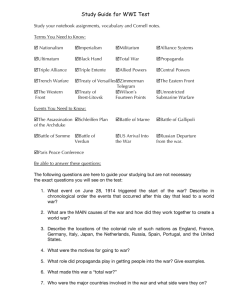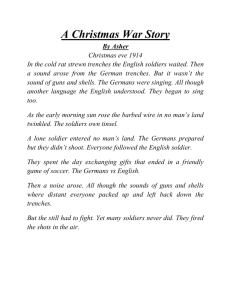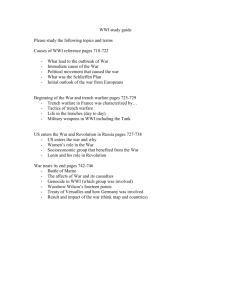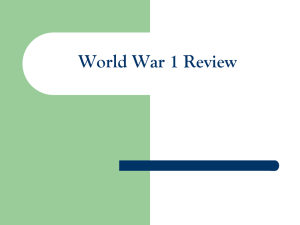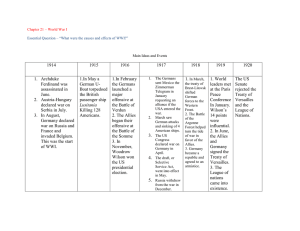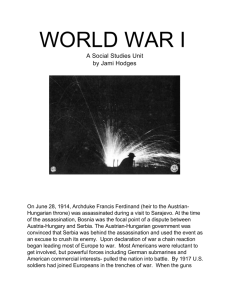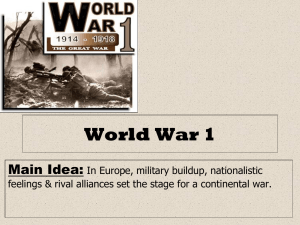File - New Haven School
advertisement
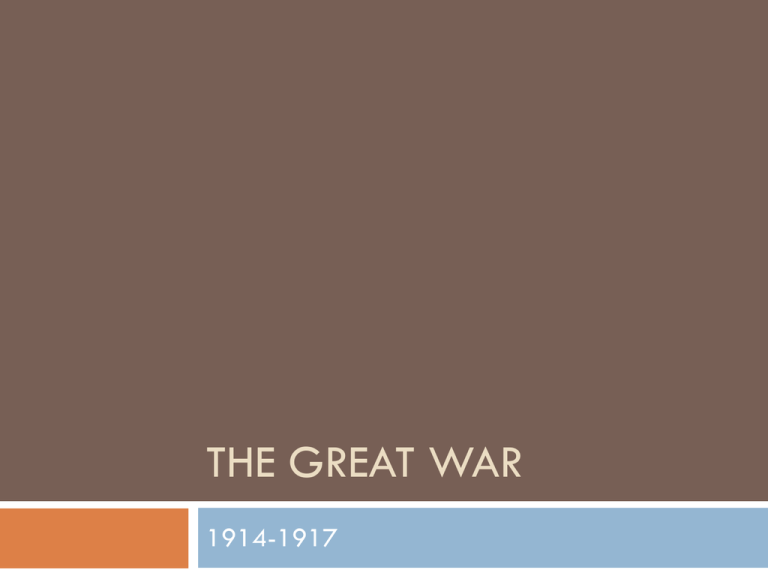
THE GREAT WAR 1914-1917 Causes of WWI Four Long Term Causes Imperialism Militarism Nationalism Alliance System Immediate Cause- The Spark Assassination of Archduke Franz Ferdinand by Serbian nationalist Gavrilo Princip Alliances line up and war is declared Alliances Central Powers- Germany, Austria-Hungary, Ottoman Allies- France, Great Britain, Russia, Japan Italy WWI Footage New Technology The First World War was a violent crash of old and new. Stationary lines faced each other in the tradition of old style warfare, but now they were trying to do so with new weaponry. Big Bertha- a German canon which could hurl an 1,800 pound shell a distance of 75 miles. Machine Gun- sprayed 600 rounds of ammunition per minute. Barbed Wire- tore the skin and had to be cut through which slowed soldiers down and made them vulnerable to attack. Poison Gas- tubes spewed poison gas. Germans discharged a fog of chlorine which suffocated two entire French divisions. Gas masks became standard equipment. Tank- ran on caterpillar treads and were built of steel so that bullets bounced off. The British learned how to gather large numbers of tanks and drive them through barbed wire defenses against the enemy, clearing a path for the infantry. Airplanes- early airplanes were flimsy. Dogfights resembled duels. Pilots sat in open cockpits and shot at each other with pistols. Eventually, planes were mounted with machine guns. The planes became faster and able to carry heavy bomb loads. New Technology The Fronts Western Front- Region of northern France where forces of the Allies and Central Powers battled each other “Terrain of Death”- 500 miles from the North Sea to the Swiss border Eastern Front- Stretch of battlefield along the German and Russian border. Russians and Serbs battled Germans and Austro-Hungarians. Fighting Starts Home by Christmas Battle of the Marne September 2, 1914German armies had pushed to within 26 miles of Paris. The French halted the German advance, aided by the taxicab drivers of Paris who shuttled hundreds of men to the battlefront. Battle of Verdun 1916- longest battle of the war fought between the Germans and the French Christmas Truce Silent Night Holy Night Trench Warfare Spring 1915- Combination of machine guns and heavy artillery made life above ground too dangerous Opposing armies dug a series of trenches from which to defend themselves and to launch attacks. Two lines of deep, rat infested trenches zigzagged across northern and eastern France Enemies fought and died for yards. Stalemate- Trench warfare continued for three years Life in the trenches- bleak and uncomfortable. Wide enough for two people to pass and provided little shelter from the elements Boring- activity occurred at night, when soldiers could repair their dugouts under cover of darkness. Attacks usually came before dawn, when most soldiers going “over the top” were mowed down by enemy fire. Life in the trenches seemed hopeless. Trench Warfare Trench Warfare “Nothing to see but bare mud walls, nowhere to sit but on a wet muddy ledge; no shelter of any kind against the weather except the clothes you are wearing; no exercise you can take in order to warm yourself.” As one soldier said, “There doesn’t seem the slightest chance of leaving except in an ambulance.” No Man’s Land No Man’s Land- the space between the German trenches and the Allied trenches, a barren expanse of pockmarked mud with shell craters and filled with barbed wire entanglements. Every once in a while, the soldiers would climb out of their trenches and try to overrun the enemies lines, while machine guns blazed and poison gas filled the air. Battle of the Somme A Bloody Turning Point- July 1, 1916- November 1916. Eight miles of German-held territory gained. British lost 60,000 men the first day. Final Casualties- 1.2 million650,000 Germans, 420,000 British, and nearly 200,000 French. After the battle, the German high command realized they had lost most of their best officers and their army was demoralized. They could not advance so all they could do was try to keep hold of what they had gained. Aviation The Airplane Nations recognized its potential as a weapon Countries built faster and stronger aircraft Used to drop bombs and shoot one another in the sky 10,000 planes by the end of the war The Red Baron Manfred Albrecht Freiherr von Richthofen Most famous air ace of WWI Scored 80 confirmed kills before he was shot down Medical Care Fighting men faced many threats, not just form the battles, but also from lice, rats, filth, and polluted water. They smelled the stench of poison gas and the reek of decaying bodies. They suffered from lack of sleep. Shell Shock- complete emotional collapse brought about by the tension, lack of sleep, and the extreme conditions. Trench Foot- caused by standing in wet trenches for long periods of time without changing into dry socks or boots. Soldier’s toes would turn red or blue, begin to rot, and then fall off. The only solution was amputation. Trench Mouth- painful infection of the gums and throat. Going off to War Pals’ Battalions At the beginning of the war, men were encouraged to enlist with the promise they could serve with the men of their village creating Pals’ Battalions Men rushed to recruitment centers to enlist as whole groups. 3 million men enlisted and 50 town’s boasted Pals’ Battalions Men who enlisted together died together Battle of the Somme- 11th Battalion suffered 585 casualties on July 1 from the 700 who started the day Villages could loose all their men in a single battle White Feathers Great Britain- young women handed out white feathers to men out of uniform during wartime White feathers symbolized cowardice for not going out to fight. Russian Revolution Russian troops kept German forces occupied on the Eastern Front 1916- Russia’s war effort was near collapse Army was short on food, guns, ammunition, boots, and blankets 1917- Civil unrest forced Czar Nicolas to step down 5.5 million Russian solders had been wounded, killed, or taken prisoner Army refused to fight November- Communist leader Vladimir Lenin seized power and ended Russia’s involvement in WWI American Involvement Causes of American involvement in World War I Unrestrained Submarine Warfarethe German U-boats sank passenger liners carrying Americans and promised to sink any ship in British waters Sinking of the Lusitania Zimmerman Note- Germany urged Mexico to revolt against the United States and promised to support the conflict Russian Revolution- the Russians overthrew their czarist regime for what seemed to be a representative government so the fight became a coalition of democratic nations versus brutal monarchies. Declaration of War April 2, 1917- President Wilson delivered his war resolution and on April 6, the congress had passed the resolution. America had entered the First World The Draft and Training America responded to the lack of manpower with a draft. The draft required men to register with the government so that some of them could be selected for compulsory service. The Selective Service Act was passed in May 1917. By the end of 1918, 24 million men had registered. 2 million men reached Europe and three-fourths of them saw combat. The overseas army consisted mainly of men between 21 and 23. Most had not attended high school and about one in five was foreign born. The training lasted nine months, partly in the United States and partly in Europe. During this time, the men put in 17 hour days on target practice, bayonet drill, kitchen duty, and cleaning up the grounds. Real weapons were in short supply, so the men drilled with imaginary ones- rocks and wooden poles. To keep up morale, volunteer organizations provided the recruits with movies, books, and vaudeville shows. After nine months, they moved onto wherever the fighting was hottest. Doughboys American soldiers were called doughboys. This nickname may have been based on the white belts they wore which were cleaned with pipe clay or “dough.” Another source of the nickname may have been their fondness for French bread. The energy and enthusiasm of the Americans were just what the Allies needed to break the stalemate of the war. Americans in Europe American Troops went to the Western Front with freshness and enthusiasm. They had not endured three years of warfare. The American Expeditionary Force (AEF), led by General John J. Pershing, pursued aggressive combative tactics. Large numbers of Americans began fighting just in time to help stop the German advances. All told, the United States lost 48,000 men in battle, with an additional 62,000 dying of disease. More than 200,000 Americans were wounded. The Soldier’s Experience For many members of the AEF, going abroad was an eye-opening experience. Most doughboys had never ventured outside the farms or small towns where they lived. The AEF also included men from widely separated parts of the country. Living and fighting together, they developed a better sense of what it meant to be an American. Nevertheless, the war experience was devastating in many ways African Americans in WWI The proportion of African Americans in service was double their proportion in the general population. Black soldiers served in segregated units and were excluded from the navy and marines. They had separate living quarters and separate recreational facilities. The army did start to train some black officers and placed them in command of black troops. The all black 369th Infantry Regiment saw more continuous duty than any other American regiment. Women in WWI Women were not drafted. They army refused to let them enlist, but the navy accepted them in noncombat positions. 13,000 women served in the navy and marines as nurses, secretaries, and telephone operators with full military rank. Women were accepted into the Army Corps of Nurses, but without rank, pay or benefits. Sergeant York One of America’s greatest war heroes. A redheaded mountaineer and blacksmith from Tennessee, York originally sought exemption as a conscientious objector, a person who opposes warfare on moral grounds, but his appeal was denied and he was sent to a training camp in Georgia. York decided that it was morally acceptable to fight if the cause was just. On October 8, 1918, armed with a rifle and a revolver, York killed 25 Germans and with six other soldiers, captured 132 prisoners. For his heroic acts, York became a celebrity when he returned to the United States. He also received the Medal of Honor. Eddie Rickenbacker One of the most celebrated American heroes of World War I. He grew up to be a race car driver and set a world speed record before the war- 134 miles per hour Pilot for the 94thengaged in 130 air battles and downed 26 enemy planes’ Earned the title “American ace of aces” The War Ends Collapse of Germany Final Toll Mutiny started in the Germany navy as sailors and marines refused to board their ships. Groups of soldiers and workers organized and rose in rebellion. The Kaiser abdicated the throne. The German war machine and war economy were too exhausted to continue fighting. At the eleventh hour on the eleventh day of the eleventh month of 1918, Germany agreed to a cease fire that ended the war. 8.5 million soldiers died 21 million wounded Civilians died because of starvation, disease, and slaughter Europe lost an entire generation Cost- $338 billion Society- left a sense of disillusionment, insecurity, and despair It was a new kind of war. It involved the use of new technologies. It ushered in the notion of war on a grand and global scale. It left behind a landscape of death and destruction such as was never before seen.
